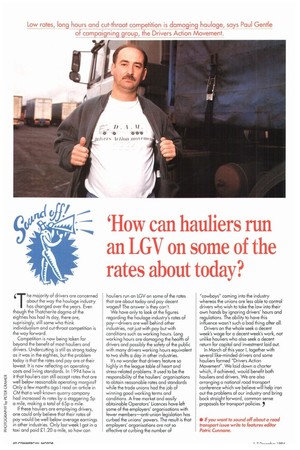'How can hauliers run an LGV on some of the rates about today?
Page 46

If you've noticed an error in this article please click here to report it so we can fix it.
g he majority of drivers are concerned
T
about the way the haulage industry has changed over the years. Even though the Thatcherite dogma of the eighties has had its day, there are, suprisingly, still some who think individualism and cut-throat competition is the way forward. Competition is now being taken far beyond the benefit of most hauliers and drivers. Undercutting is still as strong today as it was in the eighties, but the problem today is that the rates and pay are at their lowest. It is now reflecting on operating costs and living standards. In 1994 how is it that hauliers can still accept rates that are well below reasonable operating margins? Only a few months ago I read an article in CM that a well-known quarry company had increased its rates by a staggering 5p a mile, making a total of 65p a mile. If these hauliers are employing drivers, one could only believe that their rates of pay would be well below average earnings in other industries. Only last week I got in a taxi and paid 21.20 a mile, so how can hauliers run an LGV on some of the rates that are about today and pay decent wages? The answer is they can't. We have only to look at the figures regarding the haulage industry's rates of pay—drivers are well behind other industries, not just with pay but with conditions such as working hours. Long working hours are damaging the health of drivers and possibly the safety of the public with many drivers working hours equivalent to two shifts a day in other industries. It's no wonder that drivers feature so highly in the league table of heart and stress-related problems. It used to be the responsibility of the hauliers' organisations to obtain reasonable rates and standards while the trade unions had the job of winning good working terms and conditions. A free market and easily obtainable Operators' Licences have left some of the employers' organisations with fewer members—anti-union legislation has curbed the unions' powers. The result is that employers' organisations are not so effective at curbing the number of
"cowboys" coming into the industry whereas the unions are less able to control drivers who wish to take the law into their own hands by ignoring drivers' hours and regulations. The ability to have this influence wasn't such a bad thing after all.
Drivers on the whole seek a decent week's wage for a decent week's work, not unlike hauliers who also seek a decent return for capital and investment laid out. In March of this year I, together with several like-minded drivers and some hauliers formed "Drivers Action Movement". We laid down a charter which, if achieved, would benefit both hauliers and drivers. We are also arranging a national road transport conference which we believe will help iron out the problems of our industry and bring back straight forward, common sense proposals for transport policies., • If you want to sound off about a road transport issue write to features editor Patric Cunnane.
























































































